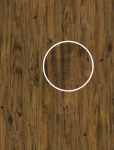I've had a home studio for some years that should be a disaster acoustically but somehow has allowed me to do some recordings that sound surprisingly good. It breaks every rule: low ceilings, carpeting, little treatment of corners, hard walls and windows, you name it. But it works—I can't fathom how. I record close-miked acoustic guitar with an array of four condenser mikes, one for the room ambiance which I keep low in the mix. As an example, here's a raw, unprocessed recording of a base guitar track with the current setup: http://edwardhamlin.com/music_downloads/First%20Light%20-%20HAMLIN.wav The reverb is natural, emanating from the guitar's soundbox itself.
Now it's time to remodel, for a variety of reasons. I was going to lay new carpeting, but now am leaning toward a product that is new to me: "luxury vinyl flooring." Sounds horrific, I know, but it's not what you think of when you think vinyl.

This is a modern, high-tech product. In real life it is a pretty damned convincing simulation of real, satin-finish hardwood, with grain indentations and nice veining. Tons better looking than laminate and almost as good as manufactured hardwood at a fraction of the price. Advantages for my basement space are that it is 100% waterproof and does not require a subfloor - it goes right on the slab. That was key because of the low ceilings, which would feel even lower if I had to raise the level of the floor. So, despite the cringe-worthy name, I will probably go with it.
The acoustic effect will be interesting. I am curious if anyone's used this product in a studio, and if so how the acoustics are. My thinking in migrating from carpeting is that it's easier to play up or play down the brightness of a recording with strategic placement of area rugs on a hardwood floor; with carpeting you have no control. And it just feels and looks nicer (even if it's luxury vinyl).
Any experiences to share? Thanks in advance.
Now it's time to remodel, for a variety of reasons. I was going to lay new carpeting, but now am leaning toward a product that is new to me: "luxury vinyl flooring." Sounds horrific, I know, but it's not what you think of when you think vinyl.

This is a modern, high-tech product. In real life it is a pretty damned convincing simulation of real, satin-finish hardwood, with grain indentations and nice veining. Tons better looking than laminate and almost as good as manufactured hardwood at a fraction of the price. Advantages for my basement space are that it is 100% waterproof and does not require a subfloor - it goes right on the slab. That was key because of the low ceilings, which would feel even lower if I had to raise the level of the floor. So, despite the cringe-worthy name, I will probably go with it.
The acoustic effect will be interesting. I am curious if anyone's used this product in a studio, and if so how the acoustics are. My thinking in migrating from carpeting is that it's easier to play up or play down the brightness of a recording with strategic placement of area rugs on a hardwood floor; with carpeting you have no control. And it just feels and looks nicer (even if it's luxury vinyl).
Any experiences to share? Thanks in advance.

